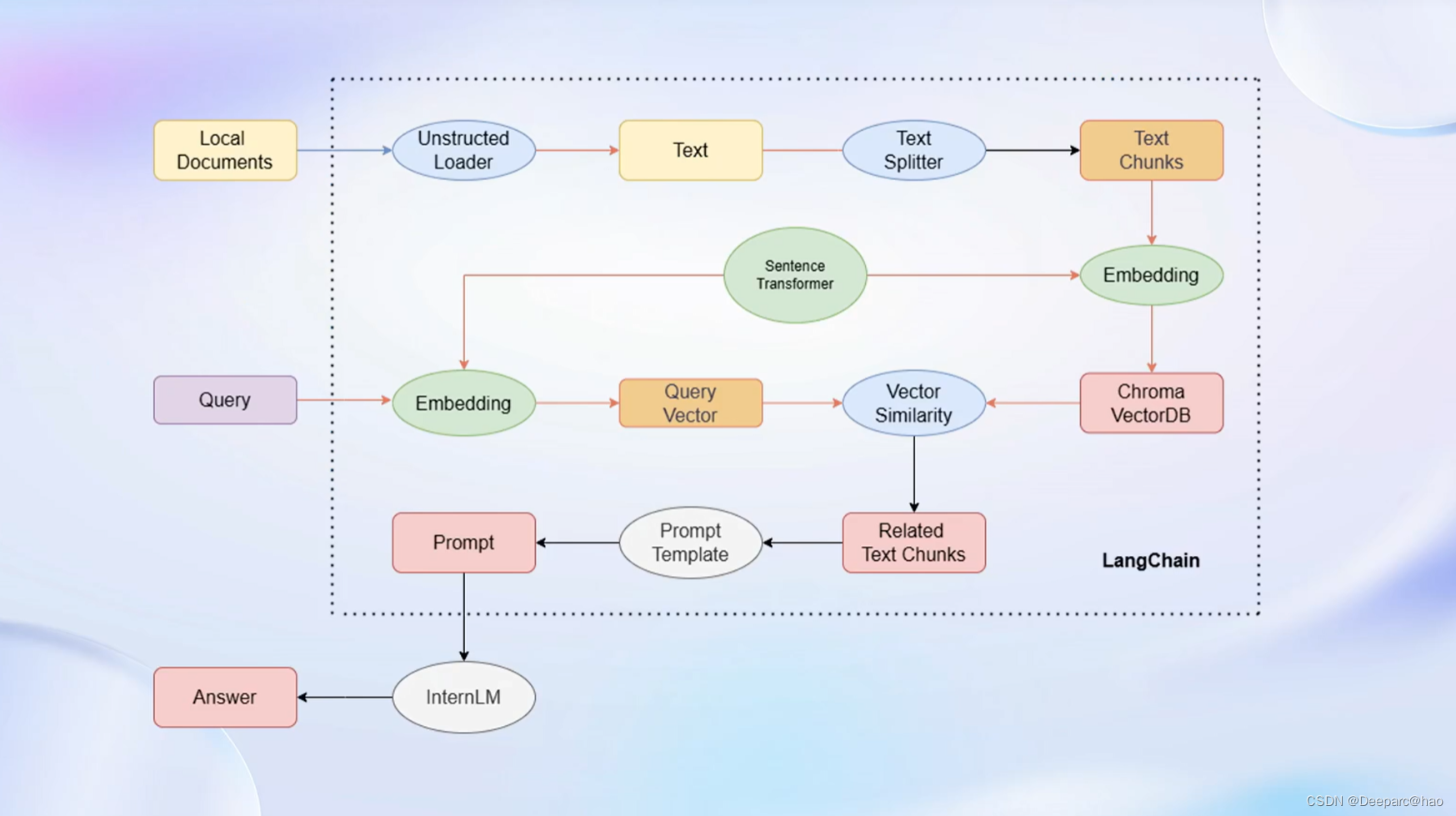书生·浦语:大模型全链路开源体系(三)——RAG
?一、RAG(Retural Augment Generation):
自chatgpt一夜爆火以来,LLM模型,展现出了惊人的发展能力和未来潜力,在人们的人常生活的方方面面发挥着,越来越重要的作用,大学生用它生成论文的草稿、企业在大模型的基础上制作新一代的智能客服,工程师们甚至用它提高芯片设计和开发的效率。
然而,大模型也存在着一些难以客服的问题,其中尤以模型幻觉和知识更新难度大成本高、专业水平不高最为严重,也限制着大模型发挥作用的空间。
为解决幻觉和知识更新的问题,提出了检索增强生成(RAG)方法。所谓RAG就相当于是给模型增加一个外部的知识库,模型遇到专业性强,以及在其训练范围之外的知识时,就可以直接从知识库中寻找,这就极大的缓解了幻觉和知识更新的问题。
大致原理:
1、数据切分
2、将切分之后的数据向量化,构建向量知识库
3、用户问题向量化
4、从向量知识库中检索相似度最高的答案
5、返回答案
二、InternLM+langchain搭建专属数据库:
1、环境配置:
基础环境配置和模型下载,已经在书生·浦语:大模型全链路开源体系(二)——InternLM、Lagent、浦语·灵笔Demo调用-CSDN博客
具体的介绍过了,这里就不再赘述了。
Langchain相关配置:
在已完成 InternLM 的部署基础上,还需要安装以下依赖包:
pip install langchain==0.0.292
pip install gradio==4.4.0
pip install chromadb==0.4.15
pip install sentence-transformers==2.2.2
pip install unstructured==0.10.30
pip install markdown==3.3.7?同时,我们需要使用到开源词向量模型?Sentence Transformer:
# 需要使用 huggingface 官方提供的 huggingface-cli 命令行工具。安装依赖:
pip install -U huggingface_hub
# 在 /root/data 目录下新建python文件 download_hf.py,填入以下代码:
import os
# 设置环境变量
os.environ['HF_ENDPOINT'] = 'https://hf-mirror.com'
# 下载模型
os.system('huggingface-cli download --resume-download sentence-transformers/paraphrase-multilingual-MiniLM-L12-v2 --local-dir /root/data/model/sentence-transformer')?然后,在?/root/data?目录下执行该脚本即可自动开始下载:
python download_hf.py
下载 NLTK 相关资源:
cd /root
git clone https://gitee.com/yzy0612/nltk_data.git --branch gh-pages
cd nltk_data
mv packages/* ./
cd tokenizers
unzip punkt.zip
cd ../taggers
unzip averaged_perceptron_tagger.zip之后使用时服务器即会自动使用已有资源,无需再次下载。
2、代码下载:
建议通过以下目录将仓库 clone 到本地,可以直接在本地运行相关代码:
cd /root/data
git clone https://github.com/InternLM/tutorial也可使用魔塔社区和huggingface进行下载
3、知识库的搭建:
选择选择由上海人工智能实验室开源的一系列大模型工具开源仓库作为语料库来源,包括:
- OpenCompass:面向大模型评测的一站式平台
- IMDeploy:涵盖了 LLM 任务的全套轻量化、部署和服务解决方案的高效推理工具箱
- XTuner:轻量级微调大语言模型的工具库
- InternLM-XComposer:浦语·灵笔,基于书生·浦语大语言模型研发的视觉-语言大模型
- Lagent:一个轻量级、开源的基于大语言模型的智能体(agent)框架
- InternLM:一个开源的轻量级训练框架,旨在支持大模型训练而无需大量的依赖
?将上述远程开源仓库 Clone 到本地,可以使用以下命令:
# 进入到数据库盘
cd /root/data
# clone 上述开源仓库
git clone https://gitee.com/open-compass/opencompass.git
git clone https://gitee.com/InternLM/lmdeploy.git
git clone https://gitee.com/InternLM/xtuner.git
git clone https://gitee.com/InternLM/InternLM-XComposer.git
git clone https://gitee.com/InternLM/lagent.git
git clone https://gitee.com/InternLM/InternLM.git之后,在\root\data目录下,新建demo目录,再新建一个create_db.py文件,输入以下代码创建向量数据库:
# 首先导入所需第三方库
from langchain.document_loaders import UnstructuredFileLoader
from langchain.document_loaders import UnstructuredMarkdownLoader
from langchain.text_splitter import RecursiveCharacterTextSplitter
from langchain.vectorstores import Chroma
from langchain.embeddings.huggingface import HuggingFaceEmbeddings
from tqdm import tqdm
import os
"""
使用 LangChain 提供的 FileLoader 对象来加载目标文件,得到由目标文件解析出的纯文本内容。
由于不同类型的文件需要对应不同的 FileLoader,我们判断目标文件类型,并针对性调用对应类型的 FileLoader,
同时,调用 FileLoader 对象的 load 方法来得到加载之后的纯文本对象:
"""
# 获取文件路径函数
def get_files(dir_path):
# args:dir_path,目标文件夹路径
file_list = []
for filepath, dirnames, filenames in os.walk(dir_path):
# os.walk 函数将递归遍历指定文件夹
for filename in filenames:
# 通过后缀名判断文件类型是否满足要求
if filename.endswith(".md"):
# 如果满足要求,将其绝对路径加入到结果列表
file_list.append(os.path.join(filepath, filename))
elif filename.endswith(".txt"):
file_list.append(os.path.join(filepath, filename))
return file_list
"""
得到该列表之后,我们就可以将它引入到 LangChain 框架中构建向量数据库。
由纯文本对象构建向量数据库,我们需要先对文本进行分块,接着对文本块进行向量化。
LangChain 提供了多种文本分块工具,此处我们使用字符串递归分割器,并选择分块大小为 500,块重叠长度为 150"""
# 加载文件函数
def get_text(dir_path):
# args:dir_path,目标文件夹路径
# 首先调用上文定义的函数得到目标文件路径列表
file_lst = get_files(dir_path)
# docs 存放加载之后的纯文本对象
docs = []
# 遍历所有目标文件
for one_file in tqdm(file_lst):
file_type = one_file.split('.')[-1]
if file_type == 'md':
loader = UnstructuredMarkdownLoader(one_file)
elif file_type == 'txt':
loader = UnstructuredFileLoader(one_file)
else:
# 如果是不符合条件的文件,直接跳过
continue
docs.extend(loader.load())
return docs
# 目标文件夹
tar_dir = [
"/root/data/InternLM",
"/root/data/InternLM-XComposer",
"/root/data/lagent",
"/root/data/lmdeploy",
"/root/data/opencompass",
"/root/data/xtuner"
]
# 加载目标文件
docs = []
for dir_path in tar_dir:
docs.extend(get_text(dir_path))
# 对文本进行分块
text_splitter = RecursiveCharacterTextSplitter(
chunk_size=500, chunk_overlap=150)
split_docs = text_splitter.split_documents(docs)
"""
接着我们选用开源词向量模型 Sentence Transformer 来进行文本向量化。LangChain 提供了直接引入 HuggingFace 开源社区中的模型进行向量化的接口"""
# 加载开源词向量模型
embeddings = HuggingFaceEmbeddings(model_name="/root/data/model/sentence-transformer")
"""
选择 Chroma 作为向量数据库,基于上文分块后的文档以及加载的开源向量化模型,将语料加载到指定路径下的向量数据库"""
# 构建向量数据库
# 定义持久化路径
persist_directory = 'data_base/vector_db/chroma'
# 加载数据库
vectordb = Chroma.from_documents(
documents=split_docs,
embedding=embeddings,
persist_directory=persist_directory # 允许我们将persist_directory目录保存到磁盘上
)
# 将加载的向量数据库持久化到磁盘上
vectordb.persist()?将该脚本和后续脚本均放在该目录下运行,运行上述脚本,即可在本地构建已持久化的向量数据库,后续直接导入该数据库即可,无需重复构建。
4、?InternLM 接入 LangChain:
为便捷构建 LLM 应用,我们需要基于本地部署的 InternLM,继承 LangChain 的 LLM 类自定义一个 InternLM LLM 子类,从而实现将 InternLM 接入到 LangChain 框架中。完成 LangChain 的自定义 LLM 子类之后,可以以完全一致的方式调用 LangChain 的接口,而无需考虑底层模型调用的不一致,在\root\data\demo目录下,创建LLM.py文件,输入以下代码:
from langchain.llms.base import LLM
from typing import Any, List, Optional
from langchain.callbacks.manager import CallbackManagerForLLMRun
from transformers import AutoTokenizer, AutoModelForCausalLM
import torch
class InternLM_LLM(LLM):
# 基于本地 InternLM 自定义 LLM 类
tokenizer : AutoTokenizer = None
model: AutoModelForCausalLM = None
def __init__(self, model_path :str):
# model_path: InternLM 模型路径
# 从本地初始化模型
super().__init__()
print("正在从本地加载模型...")
self.tokenizer = AutoTokenizer.from_pretrained(model_path, trust_remote_code=True)
self.model = AutoModelForCausalLM.from_pretrained(model_path, trust_remote_code=True).to(torch.bfloat16).cuda()
self.model = self.model.eval()
print("完成本地模型的加载")
def _call(self, prompt : str, stop: Optional[List[str]] = None,
run_manager: Optional[CallbackManagerForLLMRun] = None,
**kwargs: Any):
# 重写调用函数
system_prompt = """You are an AI assistant whose name is InternLM (书生·浦语).
- InternLM (书生·浦语) is a conversational language model that is developed by Shanghai AI Laboratory (上海人工智能实验室). It is designed to be helpful, honest, and harmless.
- InternLM (书生·浦语) can understand and communicate fluently in the language chosen by the user such as English and 中文.
"""
messages = [(system_prompt, '')]
response, history = self.model.chat(self.tokenizer, prompt , history=messages)
return response
@property
def _llm_type(self) -> str:
return "InternLM"5、web调用:
创建一个web_demo.py文件,输入以下代码:
from langchain.vectorstores import Chroma
from langchain.embeddings.huggingface import HuggingFaceEmbeddings
import os
from LLM import InternLM_LLM
from langchain.prompts import PromptTemplate
from langchain.chains import RetrievalQA
import gradio as gr
def load_chain():
# 加载问答链
# 定义 Embeddings
embeddings = HuggingFaceEmbeddings(model_name="/root/data/model/sentence-transformer")
# 向量数据库持久化路径
persist_directory = 'data_base/vector_db/chroma'
# 加载数据库
vectordb = Chroma(
persist_directory=persist_directory, # 允许我们将persist_directory目录保存到磁盘上
embedding_function=embeddings
)
# 加载自定义 LLM
llm = InternLM_LLM(model_path = "/root/data/model/Shanghai_AI_Laboratory/internlm-chat-7b")
# 定义一个 Prompt Template
template = """使用以下上下文来回答最后的问题。如果你不知道答案,就说你不知道,不要试图编造答
案。尽量使答案简明扼要。总是在回答的最后说“谢谢你的提问!”。
{context}
问题: {question}
有用的回答:"""
QA_CHAIN_PROMPT = PromptTemplate(input_variables=["context","question"],template=template)
# 运行 chain
qa_chain = RetrievalQA.from_chain_type(llm,retriever=vectordb.as_retriever(),return_source_documents=True,chain_type_kwargs={"prompt":QA_CHAIN_PROMPT})
return qa_chain
class Model_center():
"""
存储检索问答链的对象
"""
def __init__(self):
# 构造函数,加载检索问答链
self.chain = load_chain()
def qa_chain_self_answer(self, question: str, chat_history: list = []):
"""
调用问答链进行回答
"""
if question == None or len(question) < 1:
return "", chat_history
try:
chat_history.append(
(question, self.chain({"query": question})["result"]))
# 将问答结果直接附加到问答历史中,Gradio 会将其展示出来
return "", chat_history
except Exception as e:
return e, chat_history
# 实例化核心功能对象
model_center = Model_center()
# 创建一个 Web 界面
block = gr.Blocks()
with block as demo:
with gr.Row(equal_height=True):
with gr.Column(scale=15):
# 展示的页面标题
gr.Markdown("""<h1><center>InternLM</center></h1>
<center>书生浦语</center>
""")
with gr.Row():
with gr.Column(scale=4):
# 创建一个聊天机器人对象
chatbot = gr.Chatbot(height=450, show_copy_button=True)
# 创建一个文本框组件,用于输入 prompt。
msg = gr.Textbox(label="Prompt/问题")
with gr.Row():
# 创建提交按钮。
db_wo_his_btn = gr.Button("Chat")
with gr.Row():
# 创建一个清除按钮,用于清除聊天机器人组件的内容。
clear = gr.ClearButton(
components=[chatbot], value="Clear console")
# 设置按钮的点击事件。当点击时,调用上面定义的 qa_chain_self_answer 函数,并传入用户的消息和聊天历史记录,然后更新文本框和聊天机器人组件。
db_wo_his_btn.click(model_center.qa_chain_self_answer, inputs=[
msg, chatbot], outputs=[msg, chatbot])
gr.Markdown("""提醒:<br>
1. 初始化数据库时间可能较长,请耐心等待。
2. 使用中如果出现异常,将会在文本输入框进行展示,请不要惊慌。 <br>
""")
gr.close_all()
# 直接启动
demo.launch()在完成SSH连接之后(教程也在博客:书生·浦语:大模型全链路开源体系(二)——InternLM、Lagent、浦语·灵笔Demo调用-CSDN博客),运行web_demo.py文件即可。(python web_demo.py)?
?
?
本文来自互联网用户投稿,该文观点仅代表作者本人,不代表本站立场。本站仅提供信息存储空间服务,不拥有所有权,不承担相关法律责任。 如若内容造成侵权/违法违规/事实不符,请联系我的编程经验分享网邮箱:chenni525@qq.com进行投诉反馈,一经查实,立即删除!
- Python教程
- 深入理解 MySQL 中的 HAVING 关键字和聚合函数
- Qt之QChar编码(1)
- MyBatis入门基础篇
- 用Python脚本实现FFmpeg批量转换
- DeepBI:颠覆传统数据分析,AI助力一键式洞察
- Centos单用户模式修改root密码
- 用Java编程实现一个矢量绘图软件,该软件可以选择不同的绘制图形(椭圆、矩形、线条),并可以选中图形,修改图形属性(线条粗细与颜色、填充方式与颜色),拖动位置,改变大小。 (一)具体要求: (1)图形
- mysql初始化流程
- Kylin的原理
- 与纸质合同相比,电子合同有哪些优势?
- 【QT学习十一】QThread
- 图还能有数据库?一文带你了解图数据库是个什么东西!
- 解读顺网算力与AI,破局AIGC落地“最后一公里”
- 通过ADB来实现脚本来控制手机
